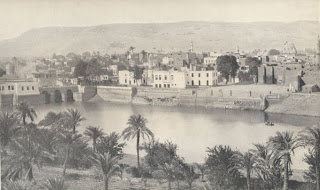Crocodilopolis?!? Copyright

EgyptHasItAll.com
Crocodilopolis ….yes it’s a real place you can
visit, and I won’t keep you guessing, it was the official head-quarters
for a crocodile worship cult! The city of
Crocodilopolis was located on the western bank of the
Nile, southwest of
Memphis in
Egypt. During ancient time it was known by the name of
Shedet and was the center of worship for the Egyptian water-god
Sobek, or the crocodile god. It was the
Greeks that dubbed it
“Crocodile City”, or
“Crocodilopolis”, but over time it has been given many names.

Its
Greek name was
Krokodilopolis but when the city passed into
Ptolemy hands in the 3rd century BC, it was renamed
Ptolemais Euergetis and then renamed again by
Ptolemy Philadelphus II to
Arsinoe in honor of his wife and sister
Arsineo II of Egypt, and during its heyday it had a population of more than 100,000. In modern time, its Arabic name is now
Medinet El-Fayoum.

Life in
Crocodilopolis has always rotated around
Lake Moeris which was in the thin ridge that separated the city from the
Nile Valley. During the
Middle Kingdom it gained prominence when the oasis swamp of
Fayoumwas drained, creating a new fertile province. The level of the lake was
artificially regulated, and large monuments were built around its
shore, although the level of the lake was lower than in the past but
still higher than today. In the 12th Dynasty the city became the
capital of
Egypt.
 Crocodilopolis
Crocodilopolis may not have become a major city and
may not have had any major political standing in the area, but it was
located in the most fertile region in
Egypt, which made it a haven for farmers growing vegetables, corn, roses, vineyards and olives.

The protective deity of the whole of the lake area was the crocodile headed god
Sobek (
Suchos) and his sacred animal was the crocodile of course! The people of
Crocodilopolis worshiped a manifestation of
Sobek through a sacred crocodile named
“Petsuchos” (or
“son of Sobek”).The
crocodile lived in a special temple, with sand, a pond and food, and
was embellished with gold and jewels and had special priests to serve
his food. When the
Petsuchos died the body would be mummified and given a special burial, and replaced by another promptly.

Beside the lake where the sacred crocodile was kept, was the principle temple, dedicated to the cult of
Sobek. During the 12th dynasty the temple already existed but was rebuilt by
Ramses II. Sadly what currently remains of
Crocodilopolis is no more than several mounds of ruins, a few column bases here and there and a
stone obelisk erected by
Senusret I during the 12th Dynasty and a few sculptured blocks. Between 1877 and 1878 a great number of
papyrus manuscripts were discovered, some of which are important to the earliest Christian history of
Egypt.
 Fayoum
Fayoum may not attract visitors on account of
Crocodilopolis but on account of its waterwheels, there are approximately 200 of these great waterwheels located throughout the oasis.
The Seven Waterwheels, which are
Fayoum’s landmark and the main attraction to the area, are surrounded by mangos, palms and willows.
Fayoum remains one of the most fertile banks on the
Egyptian Nile.
About the Author:
Gawhara Hanem
